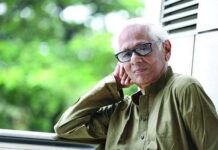
DHAKA, Bangladesh — It has been a bleak month for Bangladesh. On Jan. 5, the anniversary of last year’s general election, the opposition alliance began a series of protests called “oborodh” in Bangla, which loosely translates as blockade. These have led to over 30 deaths and effectively brought the country to a standstill.
Clashes with police and random acts of violence occur on a daily basis. Schools and factories are closed, businesses are failing, and in the capital the simple act of getting from one side of town to the other has become dangerous. The burn unit in the Dhaka Medical College Hospital is filled with victims of firebombs hurled at buses.
The opposition’s demand for a new election — just 12 months after it boycotted last year’s — has been met by a heavy-handed government response, with many opposition leaders jailed. The result is political stalemate.
Amid this grim news, there is a small glimmer of light: the appointment of Chief Justice Surendra Kumar Sinha, a Hindu and the first minority chief justice in this Muslim-majority country. (The Hindu population is about 10 percent of the total.)
The appointment of a chief justice happens automatically in Bangladesh: When one retires, the role goes to the most senior judge of the appellate division. But in 1977, the last time the most senior judge of the appellate division was from a minority, the government of the day, headed by the Bangladesh National Party leader Ziaur Rahman (whose widow, Khaleda Zia, is now the party chairwoman, in opposition), lowered the retirement age, with the result that Justice Debesh Bhattacharya (also a Hindu) became ineligible for the role. This time around, Justice Sinha’s appointment has gone through, underlining the current prime minister’s greater commitment to diversity.
Justice Sinha has already indicated that he wishes to modernize the judiciary. On Jan. 18, in his first public address since being sworn in, he proposed the reform of colonial-era laws and a sustained effort to improve the efficiency of the courts. He also urged the judiciary to take a close look at itself and work harder, with greater transparency and in more democratic ways.
If only Justice Sinha had been around a dozen years ago, when the judicial system came crashing into my own household. Between 2001 and 2006, my father was charged with more than 30 cases of contempt and defamation. An outspoken newspaper editor, he had provoked the ire of the government, then headed by Mrs. Zia. The authorities harassed my father by getting numerous citizens to bring charges.
The cases were lodged in courts all over the country, so he spent a good deal of time traveling to plead his case. On one occasion, I accompanied him to the High Court in Dhaka, where he was defending a contempt case lodged by the father of a recently appointed High Court judge.
The daily newspaper Prothom Alo, of which my father was then the publisher, had reported on the sudden nomination of 19 judges to the High Court. It was unprecedented, at the time, for so many to be appointed all at once, and the newspaper decided to investigate.
Checking the new judges’ credentials, a Prothom Alo reporter found that one had forged his university examination results, giving himself a pass when he had, in fact, failed a portion. The investigation had been carried out by the university; the newspaper merely reported it. All the same, the judge’s father sued my father for contempt.
I was struck by how my father’s lawyer and the judge discussed the case: They engaged in a lively, rather friendly conversation about the contempt law. In the end, though, the judge could not but convict my father. Because of the way the law is written, “truth is not a defense,” he said.
In other words, it did not matter whether the report was true or not, only that a negative story had been printed about a judge. This notoriously vague law was written in the days when judges were colonial administrators and the accused were their subjects.
Other colonial laws, like those governing the prosecution of rape, are also in dire need of reform. In India, a commission led by that country’s former chief justice, J.S. Verma, reviewed the legal code on rape and recommended a new, broader definition of the crime. Similar reform in Bangladesh, where there is a culture of victim-blaming and there are few convictions for rape, would have tremendous impact.
Justice in Bangladesh is held back not only by obsolete laws, but also by an overworked system. There are more than 300,000 cases pending in the Supreme Court, and a staggering 2.4 million cases in the district courts.
Justice Sinha has proposed doubling the number of judges, and has called for more automation of the courts’ administrative functions. “The law is not like an antique to be taken down, admired and put back on the shelf,” he said. He wants his courts to enjoy the “full public confidence and credibility of all.”
In the current political climate, it is difficult to find cause for celebration. Nor does it mean that Bangladesh’s treatment of minorities has fundamentally changed. The Chittagong Hill Tracts, which is home to a large indigenous population, remain heavily militarized, with outbreaks of violence on a regular basis.
There is a culture of repression in the legal system, too, that is alarming. And the mandate for the head of the judiciary is not an easy one: to strengthen the integrity and political neutrality of our courts.
Justice Sinha’s appointment is no panacea. But if he stands by his opening remarks, Justice Sinha can be that leader.
Source: The New York Times










It would be interesting how the writer forgot t write a bit about the thousands of cases against the politicians of BNP and Jamaat. The number of cases cases doubled or tripled since the period 2001-2006. New laws were added in which one would be charged if he/she make unfavorable comments about the ruling family and many more such laws. In a nutshell, one never knows when he/she acted against a law of the land.